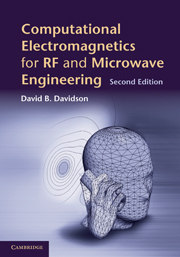Book contents
- Frontmatter
- Dedication
- Contents
- Preface to the second edition
- Preface to the first edition
- Acknowledgements
- To the reader
- List of notation
- 1 An overview of computational electromagnetics for RF and microwave applications
- 2 The finite difference time domain method: a one-dimensional introduction
- 3 The finite difference time domain method in two and three dimensions
- 4 A one-dimensional introduction to the method of moments: modelling thin wires and infinite cylinders
- 5 The application of the FEKO and NEC-2 codes to thin-wire antenna modelling
- 6 The method of moments for surface modelling
- 7 The method of moments and stratified media: theory
- 8 The method of moments and stratified media: practical applications of a commercial code
- 9 A one-dimensional introduction to the finite element method
- 10 The finite element method in two dimensions: scalar and vector elements
- 11 The finite element method in three dimensions
- 12 A selection of more advanced topics in full-wave computational electromagnetics
- Appendix A The Whitney element
- Appendix B The Newmark-β time-stepping algorithm References
- Appendix C On the convergence of the MoM Reference
- Appendix D Useful formulas for simplex coordinates
- Appendix E Web resources
- Appendix F MATLAB files supporting this text
- Index
- References
12 - A selection of more advanced topics in full-wave computational electromagnetics
Published online by Cambridge University Press: 05 July 2014
- Frontmatter
- Dedication
- Contents
- Preface to the second edition
- Preface to the first edition
- Acknowledgements
- To the reader
- List of notation
- 1 An overview of computational electromagnetics for RF and microwave applications
- 2 The finite difference time domain method: a one-dimensional introduction
- 3 The finite difference time domain method in two and three dimensions
- 4 A one-dimensional introduction to the method of moments: modelling thin wires and infinite cylinders
- 5 The application of the FEKO and NEC-2 codes to thin-wire antenna modelling
- 6 The method of moments for surface modelling
- 7 The method of moments and stratified media: theory
- 8 The method of moments and stratified media: practical applications of a commercial code
- 9 A one-dimensional introduction to the finite element method
- 10 The finite element method in two dimensions: scalar and vector elements
- 11 The finite element method in three dimensions
- 12 A selection of more advanced topics in full-wave computational electromagnetics
- Appendix A The Whitney element
- Appendix B The Newmark-β time-stepping algorithm References
- Appendix C On the convergence of the MoM Reference
- Appendix D Useful formulas for simplex coordinates
- Appendix E Web resources
- Appendix F MATLAB files supporting this text
- Index
- References
Summary
In this final chapter, we conclude the main part of this book with a selection of more advanced topics. Although primarily relating to the finite element method, hybridization with both the MoM and FDTD will be discussed, so as a final chapter it appropriately draws together these three apparently quite different methods.
The previous chapter concluded with one method for terminating open-region problems with radiation boundary conditions, specifically the use of an absorbing boundary condition. An alternative to the application of an approximate local ABC is to use an exact global RBC, the MoM; this leads to the hybrid FEM/MoM formulation. This approach has proven very powerful for specialized applications, and an application to radiation exposure assessment near a base-station antenna will be presented.
To this point in this book, all the finite element work has proceeded in the frequency domain; in this chapter, time domain finite element analysis (FETD) is discussed, and a connection made with the FDTD, which is explored in detail, revisiting the one-dimensional wave analysis problem introduced in Chapter 9 in the time domain. This connection permits the consideration of hybrid FETD/FDTD schemes.
We conclude the chapter with a discussion on two issues which impact on efficiency. Firstly, sparse matrix storage schemes are briefly outlined, and secondly, error estimation and the use of mesh adaptation based on this is discussed.
The coverage in this chapter is at a higher level than in much of the rest of this book.
Information
- Type
- Chapter
- Information
- Computational Electromagnetics for RF and Microwave Engineering , pp. 451 - 483Publisher: Cambridge University PressPrint publication year: 2010
